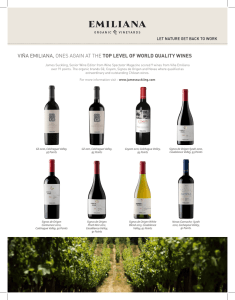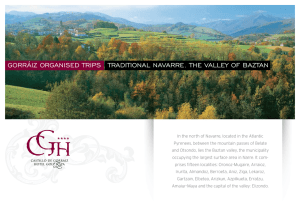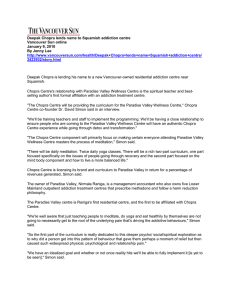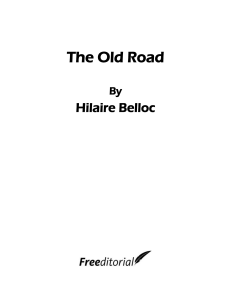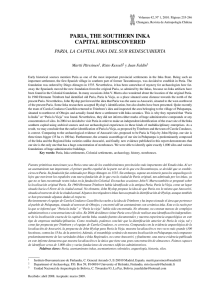Front Section - Columbia University
Anuncio
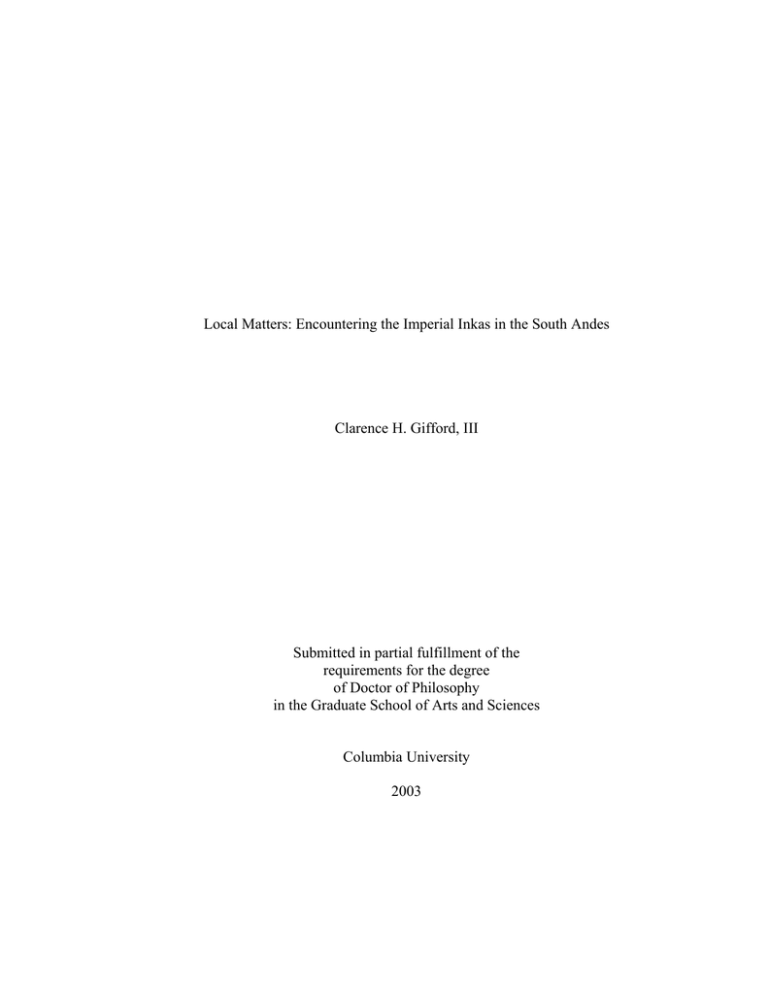
Local Matters: Encountering the Imperial Inkas in the South Andes Clarence H. Gifford, III Submitted in partial fulfillment of the requirements for the degree of Doctor of Philosophy in the Graduate School of Arts and Sciences Columbia University 2003 © 2003 Clarence H. Gifford, III All Rights Reserved ABSTRACT Local Matters: Encountering the Imperial Inkas in the South Andes Clarence H. Gifford, III This thesis strengthens our understanding of culture contact under state expansion by recognizing the forces of local history and culture within broader political and economic structures. It considers a series of prehistoric colonial encounters between the Inka state and indigenous societies in northwest Argentina in the Calchaquí Valley, which was partially incorporated into the Inka empire in the 15th century AD. In the course of 150 years prior to the Spanish conquest of South America in AD 1532, the Inkas seized control of hundreds of Andean societies to create the largest state ever formed in the prehispanic Americas. Reconstructing colonial encounters archaeologically requires careful attention to the materiality of culture contact. The data presented in this thesis were generated through analyses of settlement planning, architecture, and excavated ceramic, faunal, and lithic remains from 13 prehispanic settlements in the Calchaquí Valley. These sites were investigated systematically through both archaeological surface study and excavation. The surface study included the preparation of detailed site maps and the collection of measured variables from 1170 walls and 202 architectural features in 310 standing structures. The excavation portion of the research, which was designed to obtain sufficient material to facilitate statistical analyses, included 38 test-pit excavations evenly distributed between the 13 study sites. This thesis, then, traces in the data the social transformations that occurred during colonial contact in the region, including the ways that groups modified their landscapes, how space and architecture were re-formed within affected societies, and how relations changed within regional socioeconomic systems. Some findings reveal that colonial encounters were frequently negotiated over local sacred places, showing the persistence of indigenous ideologies. The creation of hybrid spaces and architecture, which involved the localization of foreign standards, also underscored indigenous initiative in constructing arenas of interaction. The interpretations of colonialism that appear in this thesis, therefore, contribute to our understanding of culture contact by highlighting how the forces of indigenous self-determination, compliance, resistance, accommodation, and cooperation transfigure imperial encounters. RESUMEN Asuntos Locales: Encontrando al Imperio Inka en los Andes del Sur Clarence H. Gifford, III Esta tesis busca fortalecer nuestro entendimiento sobre las situaciones de contacto cultural que tienen lugar en contextos de expansión estatal, teniendo en cuenta el rol jugado por la historia y la cultura local dentro de estructuras políticas y económicas mayores. Específicamente, la tesis estudia los contactos culturales prehistóricos entre el estado Inka y las sociedades indígenas del valle Calchaquí, en el Noroeste Argentino; región que fue parcialmente anexada al Imperio Inka en el siglo XV de nuestra era. Con anterioridad a la conquista española de Sudamérica, acaecida en el año 1532 de la era, los Inkas ejercieron durante aproximadamente 150 años control sobre cientos de sociedades andinas, creando así uno de los estados más grandes alguna vez formados en la América prehispánica. La reconstrucción arqueológica de encuentros coloniales requiere una cuidadosa atención sobre la materialidad de la cultura del contacto. La información presentada en esta tesis fue generada a través del análisis de la planificación de los asentamientos, la arquitectura, y la cerámica, artefactos líticos y los restos de fauna recuperados de 13 sitios prehispánicos del valle Calchaquí. Estos asentamientos fueron investigados sistemáticamente a partir de estudios arqueológicos de superficie y excavaciones. Los estudios de superficie incluyeron la confección de planos detallados de los sitios y la recolección de información métrica de 1170 muros y 202 rasgos arquitectónicos de 310 estructuras y edificios. En lo que respecta a las excavaciones, que fueron diseñadas para obtener suficiente material arqueológico que facilitase el empleo de análisis estadísticos, las mismas incluyeron 38 unidades de sondeo uniformemente distribuidas entre los 13 sitios estudiados. Esta tesis, así, estudia las transformaciones sociales que tuvieron lugar en la región durante momentos de contacto cultural. Específicamente se tiene en cuenta la manera en que los grupos modificaron el paisaje, cómo el espacio y la arquitectura de las sociedades afectadas por este proceso fueron reformadas, y cómo las relaciones cambiaron dentro de los sistemas socioeconómicos regionales. Algunos de los hallazgos revelan que estos encuentros coloniales fueron frecuentemente negociados dentro de espacios sagrados locales, lo que demuestra la persistencia de las ideologías indígenas. La creación de espacios y arquitectura híbrida, los cuales involucraban el uso de normas y patrones foráneos, también enfatiza las iniciativas locales por construir arenas de interacción. Las interpretaciones sobre colonialismo que aparecen en esta tesis, por lo tanto, contribuyen a nuestro entendimiento sobre situaciones de contacto cultural, especialmente resaltando cómo las fuerzas locales de autodeterminación, conformidad, resistencia, adaptación y cooperación transfiguran los encuentros imperiales. TABLE OF CONTENTS List of Illustrations iii Acknowledgements v Chapter 1 - Introduction and Research Overview 1 The Archaeology of Imperialism and Colonialism The Calchaquí Valley: The Setting and Its Chronologies Chapter Overviews Chapter 2 - The Archaeology of Colonial Encounters 34 Comparative Colonialism in Archaeology Inka Colonialism The Northern Calchaquí Valley and Inka Studies Chapter 3 - Research Methods 71 Fieldwork Activities Laboratory Study Chapter 4 - Chronology in the Northern Calchaquí Valley 103 Archaeological Chronologies in the Northern Calchaquí Valley Results of Radiocarbon Assays Quantitative Analyses of the Material Culture Data A Chronology of Site Occupation in the Northern Calchaquí Valley Conclusion Chapter 5 - Affiliation in the Northern Calchaquí Valley Previous Research Data Analysis Northern Calchaquí Valley Affiliations in the Later Periods Conclusion 169 Chapter 6 - Activities in the Late Periods in the Northern Calchaquí Valley 218 Data Analysis: Portable Artifacts Data Analysis: Architecture and Site Planning Site and Valley Sector Summaries Conclusion Chapter 7 - Interaction in the Late Periods in the Northern Calchaquí Valley 265 Elite Life, Wealth Displays and Decorated versus Undecorated Ceramic Material Settlement in the Inka period in the Northern Calchaquí Valley Architecture and Space at Cortaderas Bajo Discussion Chapter 8 - Inka Colonial Encounters in the Northern Calchaquí Valley 308 Overview of Inka Colonial Encounters in the Northern Calchaquí Valley Discussion of Inka Colonial Encounters in the Northern Calchaquí Valley Conclusion Footnotes 345 Appendices 346 Bibliography 438 LIST OF ILLUSTRATIONS Charts: Chart 1: Chronological plot of calibrated radiocarbon dates Chart 2: Inka Provincial ceramics per 14C-dated deposit Chart 3: Changes in the occurrence of ceramic temper over time Chart 4: Change in the occurrence of ceramic tempers by valley sector Chart 5: Change in felsite vs. mica and sand tempers by valley site and sector Chart 6: Percentage change in ceramic surface treatment by time period Chart 7: Scatter plot and trendline: calendar dates versus wall thickness Chart 8: Change in percentages of wall binder types over time Chart 9: Frequencies of pirka and core-filled walls by study sites Chart 10: Occurrence of lithic material in the Formative and DR periods Chart 11: Occurrence of walls with and without upright stones by study site Chart 12: Occurrence of rectified versus shaped structures by study site Chart 13: Frequency distribution of wall thickness across all data Chart 14: Comparative distributions of ceramic vessel form by site Chart 15: Comparative distributions of ceramic vessel form by structure type Chart 16: Regional origins of ceramics by time period Chart 17: Regional origins of ceramics by valley sector Chart 18: Scatter plot of lithic debris by sector, density versus frequency Chart 19: Comparative frequency distribution of animal bone by valley sector Chart 20: Densities of animal body parts by structure type Chart 21: Frequency of animal body parts by time period Chart 22: Comparative distributions of structure types by time period Chart 23: Frequency distribution of ASD counts and total ASD surface area Chart 24: Plot of ASD counts versus total ASD surface area by site and time period Chart 25: Frequency of roofed/unroofed space as a percentage at the study sites Chart 26: Comparative distributions of decorated/undecorated ceramics by site Chart 27: Distributions of decorated/undecorated ceramics by structure type Tables: Table 1: Study sites-- originally proposed versus actually studied Table 2: Total artifacts recovered by study site Table 3: Carbon samples selected for dating and their provenience Table 4: Chronological information from artifact categories by site and time period Table 5: Radiocarbon samples, dates and calibrations Table 6: Radiocarbon samples, dates and calibrations from SC042 Table 7: Percentages and counts of ceramic types by time period Table 8: Change in occurrence of red slip on ceramics by time period Table 9: Averages of structure surface area by time period Table 10: Occurrence of walls that are freestanding versus shared by time period Table 11: Occurrence of rectified versus shaped structures by time period Table 12: Descriptions and codes of types of wall binders Table 13: Occurrence of ceramic types from all excavated contexts Table 14: Occurrence of ceramic types by site and valley sector Table 15: Basic wall data for each of the study sites Table 16: Distribution of freestanding and shared walls by study site Table 17: The presence/absence of certain features near the study sites Table 18: Occurrence of structures within structures at SC065 vs. all other sites Figures: Figure 1: Map of South Andes Figure 2: The Northern Calchaquí Valley, Salta (Argentina) Figure 3: Map of the greater Calchaquí Valleys Figure 4: Chronology of the Calchaquí Valley and neighboring areas Figure 5: Route map of the Northern Calchaquí Valley Figure 6: Trigal, La Poma Figure 7: Profile of excavation unit RLP16=4-9-1 Figure 8: Plan of SC042 (Potrero de Payogasta), Northern Calchaquí Valley Figure 9: The sectors of La Poma, Potrero Valley and Main Valley Figure 10: Plan of Guitián, Northern Calchaquí Valley Figure 11: The Cortaderas settlement, Northern Calchaquí Valley Figure 12: CAD modeling methods Figure 13: Constructing a gaze Figure 14: Plan of SC065 (Cortaderas Bajo), Northern Calchaquí Valley Figure 15: Schematic view of the saddle of Cortaderas Bajo Figure 16: View looking north from the Cortaderas Bajo patio Figure 17: View looking west from the Cortaderas Bajo patio Figure 18: View looking east from the Cortaderas Bajo patio Figure 19: View looking south from the Cortaderas Bajo patio Figure 20: Plan of the patio complex at Cortaderas Bajo with access route Figure 21: Viewshed from Cortaderas Bajo looking south Figure 22: View looking south from the patio exit at Cortaderas Bajo ACKNOWLEDGEMENTS I thank my committee members for their exceptional support and mentoring over the years. First among them is Terry D'Altroy, my sponsor, mentor and friend, who has been the fulcrum of my professional training. I am indebted to him for introducing me to the rigors of anthropological archaeology in the classroom and for inviting me to work with him in Argentina. Nan Rothschild, my committee chair, also helped me understand in class what it means to think like an anthropologist, and has consistently provided me with wise and timely advice. Lynn Meskell supplied fresh blasts of critical air in a number of crucial moments and for this I am grateful. From Marc Van De Mieroop I learned how strong and deep academic dedication can run and from Craig Morris I learned what it means to be professional. Lastly, Elsa Redmond sat on my committee in its earliest form, giving me with invaluable insights into the machinations of scientific archaeology. Dissertation research was made possible by a number of permitting and granting institutions. The Secretaría de Cultura of the Ministerio de Educación (Province of Salta), the Museo de Antropología de Salta, and the Museo Arqueológico de Cachi kindly granted permission for the field and laboratory work in the Calchaquí Valley. The particular officials that oversaw my work include Arg. Mario Lazarovich (Ex-Director de Patrimonio Cultural of the Secretaría de Cultura), Prof. Carmen Martorell (Director de Patrimonio Cultural of the Secretaría de Cultura), and Dir. Miguel Xamena (Director of the Museo Arqueológico de Cachi). Prof. Eleonora Mulvany of the Universidad Nacional de Salta also provided this project with expert guidance. Fieldwork was primarily funded by a 1998 National Science Foundation Doctoral Dissertation Improvement Grant (BCS-9810839) and secondarily by a generous group of family and friends. The stars in my research universe include Terry D'Altroy, Félix Acuto, Verónica Williams, Elizabeth DeMarrais, Kirsten Olson and Miguel Xamena, who helped guide me through the different phases of my research. I thank Terry for allowing me to participate on the Proyecto Arqueológico Calchaquí and for visiting sites with me during the first few weeks of my project. I thank Félix for the critical challenges he always proposes, which force me to think carefully and creatively. I thank Verónica for sharing with me her insight and knowledge about Argentine archaeology and for helping me organize and refine my fieldwork methods. I thank Liz for blazing a trail in the Calchaquí for the rest of us to follow-- her intelligent research provided both inspiration and an excellent starting point for my own work. Kirsten's unconditional support of my research and critical insights kept me going throughout. Miguel also provided encouragement, insights, resources, and good humor during my time in Cachi. I next want to acknowledge many of the citizens of the town of Cachi itself. The professional and knowledgeable staff at the Museo Arqueológico de Cachi showed me unlimited kindness, support and access to the museum collections and library. These individuals include René and Demetrio, who also helped me in the field, and Manuela, Lili, Marta and Lidia, who made working in the Museo a delight. In Cachi, I was generously welcomed and cared for by, among others, Miguel and Viviana Xamena, Julia Díaz, Roberto Duran, Marcello and Laura Patron, and Luis Peroti. Many people participated on this project in the field and in the lab, and each deserves special mention for the skills and ideas that they contributed. First among these is Antonio Emiliano Mercado Sanz, to whom I owe a great deal of my gratitude. Toni was instrumental at nearly every stage of the project and contributed endlessly in the field and in the laboratory (and in the cold water of the Río Calchaquí helping process flotation samples). I am grateful to these people, who also helped in the field: Terry D'Altroy, Verónica Williams, Liliana Aguirre, Federico Viveros, Nani Lamagni, Nicolas Antonio Maioli, Sarah Muir, Kirsten Olson, Félix Acuto, Cristian Eduardo Jacob, Maria Luján Bravo, and Alba Raquel Guardatti. In the laboratory I received help and insight from Flavio Ruiz Alemandi and Kirsten Olson. Mabel Mamani made a brief appearance on the project and helped translate a number of field forms from English into Spanish. A handful of friends and colleagues from Buenos Aires contributed their time and energy to help this project along, including Leandro Hernán Luna and Claudia Marcela Aranda, who measured and analyzed the infant osteological remains from the RC078 urn burial, and Marisa Lazzari and Félix Acuto, who helped me sort out the origins of some of the Humahuaca ceramics that were recovered at RC078. Back in the United States, I am grateful to my fellow students at Columbia University who helped with the painful task of proofreading data; these include Kelly Britt, Heather Atherton, Christine Chen, Scott Kremkau, Anna Boozer and Kirsten Olson. Thanks, also, to the office staff in the Columbia Department of Anthropology for helping me keep many of the details of my graduate school adventure in good order. Next, a number of people stepped in during the data analysis and writing portions of this project to offer guidance, feedback and encouragement. Terry D'Altroy helped me conceive of, structure and execute my analyses. I am grateful to Timothy Jull and the staff at the NSF-University of Arizona AMS Facility for processing seven of my radiocarbon samples at no cost through their Student Researchers Program. I am grateful to David Lentz at the New York Botanical Gardens for allowing me to use his microscopes and for his patience in teaching me how to identify some of the botanical materials. I am grateful to Félix Acuto for helping me develop the ideas presented in Chapter 8 about architecture and space at Cortaderas Bajo, and to Kirsten Olson and Marisa Lazzari for providing me feedback on these ideas when they first appeared in a conference paper. Kirsten also captured photographically the background images used in the renderings that appear in Chapter 8 and Porter Gifford Productions provided technical and aesthetic guidance in preparing the same. Finally, Terry D'Altroy, Nan Rothschild and Lynn Meskell carefully read and commented on an earlier draft of this thesis. The name Kirsten Olson appears repeatedly in these acknowledgements as she contributed to my project in countless ways. Kirsten is at once a friend and colleague and this thesis would be half what it is if not for her intelligent challenges and her caring encouragement. Above and beyond this thesis stands Betsy Morgan, without whom this tome would still be a printer's ream. I am blessed to have Betsy in my life as she provides every type of support unconditionally, including emotional, spiritual, intellectual, editorial and financial. I dedicate this thesis and my work to her. For Betsy L. Morgan

